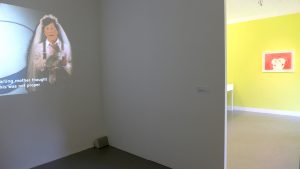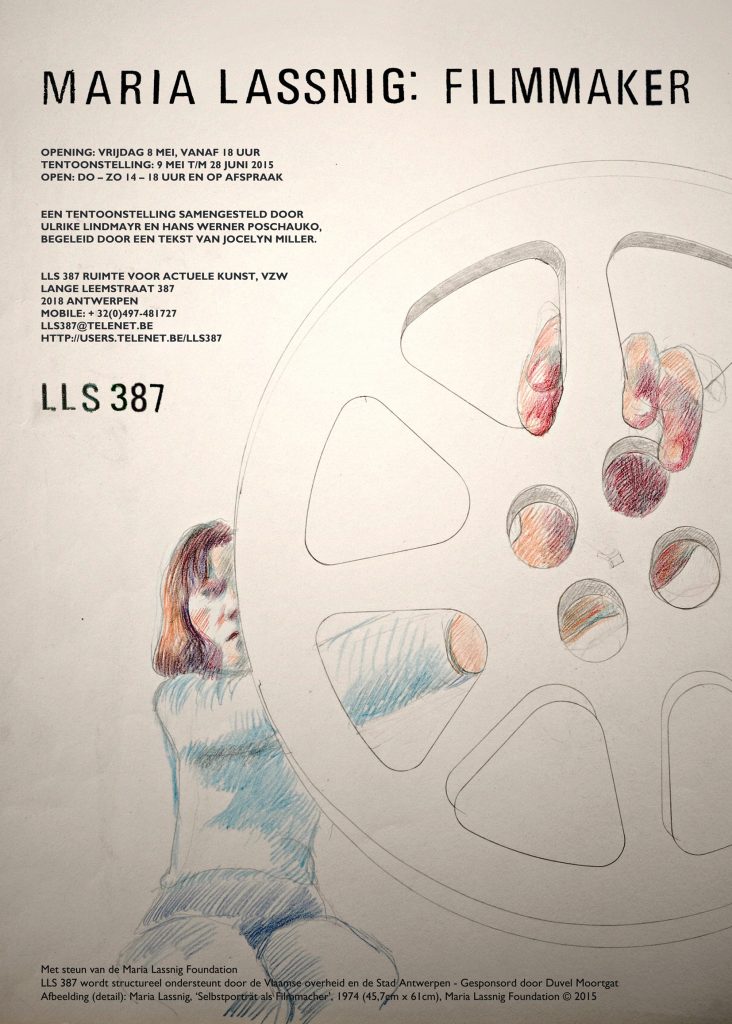Maria Lassnig: Filmmaker.
3 animationfilms, drawings and archival material
03.05.2015 — 28.06.2015
An exhibition curated by Ulrike Lindmayr (LLS 387) and
Hans Werner Poschauko (Maria Lassnig Foundation, Vienna),
guided by a text by Jocelyn Miller (curator at the MoMA PS1, New York).
[NL]
Maria Lassnig (Oostenrijk, 1919 – 2014) was een van de meest belangwekkende schilders van onze tijd. Haar opmerkelijke carrière beslaat meer dan zeven decennia. Eind jaren 1940 volgde ze een opleiding aan de Akademie der bildenden Künste in Wenen, een stad waar ze later ook zelf les gaf. In de jaren 1950 en 1960 werkte ze in Parijs en in de jaren 1970 in New York en al die tijd exploreerde ze in haar werk op een zowel gevoelige als kwetsbare manier het lichaam.
Lassnig produceerde een uitgebreid en bijzonder eigenzinnig oeuvre bestaande uit schilderijen, tekeningen en films die in geen bepaalde stroming zijn onder te brengen. Lassnig, die aanvankelijk werd beïnvloed door haar surrealistische tijdgenoten, ging in 1951 voor het eerst naar Parijs, waar ze kennis maakte met het abstract expressionisme en de art informel van Amerikaanse en Franse schilders. Haar exploratie van de abstractie bleef echter altijd geworteld in het lichamelijke.
Volgens Lassnig heeft de tijd dat ze in New York woonde (van 1968 tot 1980) de grootste invloed gehad op haar werk. Ze was zich scherp bewust van de vele mogelijkheden tot experimenteren, de beschikbaarheid van technologische uitrusting en de openheid die de filmwereld daar haar te bieden had en ze schreef zich in voor een cursus animatiefilm aan de School of Visual Arts in New York. Tussen 1970 en 1976 maakte ze dan ook een aantal korte animatiefilms. Samen met Martha Edelheit, Doris Chase, Carolee Schneemann, Rosalind Schneider, Silvianna Goldsmith, Nancy Kendall, Susan Brockman, Alida Walsh en Olga Spiegel, richtte Maria Lassnig in 1974 de feministische avant-gardegroep “WOMEN ARTIST FILMMAKERS INC” op.
Lassnig gebruikte haar ‘lichaamsbewuste’ schilderijen als basis voor haar opmerkelijk inventieve en humoristische films (vaak met haar eigen liedjes als begeleiding) die een synthese vormen van haar interesse voor schilderkunst en film.
Op de tentoonstelling in LLS 387 werden twee van haar films uit de jaren 1970 getoond: Palmistry (1973) en Art Education (1976). Ze exploreren allebei de relatie tussen vrouwen en mannen en ook de manier waarop vrouwen hun eigen lichaam ervaren en hoe ze tegenover de wereld staan: een paar abstracte vormen communiceren over seks, waarbij de mannelijke vorm duidelijk het onderspit moet delven voor de vrouwelijke aan wie hij zijn seksuele confidenties toevertrouwt; een vrouw laat haar hand lezen en verwerpt de patriarchale dominantie van haar lot; in een geestige sociale satire komt een model in opstand tegen haar schilder/meester.
De derde film die op de tentoonstelling werd getoond was Maria Lassnig Kantate (1992), een film die Lassnig twintig jaar later maakte toen ze drieënzeventig jaar was en al terug in Wenen woonde, waar ze nu zelf lessen schilderkunst en animatiefilm gaf aan de Akademie für angewandte Kunst. In Kantate vertelt Lassnig ons haar levensverhaal in 14 verzen. Ze staat in een landschap bestaande uit haar eigen schilderijen (bluebox techniek), gekleed in kostuums die een ironisch commentaar leveren op verschillende fasen van haar leven.
Lassnig had een acteurs- en komisch talent dat overal in haar werk opduikt, onder andere in haar geestige uitspraken en werktitels. Dit geldt in het bijzonder voor haar animatiefilms, waarin ze verhalende scenario’s uitwerkte die direct verband houden met haar eigen biografie, met het lichaam, schoonheid, liefde of scheiding, angst, kwelling en dwang.
De tentoonstelling presenteerde naast de drie films ook verschillende tekeningen: zelfportretten als filmmaker, storyboards, notities, schetsen en een aantal originele tekeningen die in de drie films werden gebruikt. Om de context waarin de films van Lassnig tot stand kwamen beter te schetsten, werd op de tentoonstelling eveneens autobiografisch materiaal getoond uit haar New-Yorkse periode en een aantal documenten – affiches, programmabrochures, foto’s… – die verband houden met het kunstenaarscollectief “WOMEN ARTIST FILMMAKERS”.
“Maria Lassnig: Filmmaker” was de allereerste tentoonstelling die uitsluitend de focus legde op haar films. De meeste stukken die in deze expositie getoond werden, verlieten dan ook voor het eerst het atelier / archief van Maria Lassnig.
Met Dank aan Claudia Plank, Johanna Ortner, Martin Blank en Andrea Kränzlin.
Met steun van de Maria Lassnig Foundation, de Vlaamse overheid en de Stad Antwerpen.
Gesponsord door Duvel Moortgat.
[EN]
Maria Lassnig (Austria, 1919 – 2014) was one of the most powerful painters of our time. Throughout a remarkable career that spanned more than seven decades, starting from late 1940s at the Academy of Fine Arts in Vienna and then by way of the Paris art scene of the 50s and 60s, and a long stay in New York through the decade of the 70s, she continued to create artworks that explore the body (and particularly one’s consciousness of it), in a manner both sensitive and vulnerable.
Lassnig produced a prolific and idiosyncratic body of paintings, drawings and films that defies categorization. Already long exposed to Surrealism by her contemporaries, Lassnig went to Paris for the first time in 1951, and there became acquainted with the works of the Abstract Expressionists and Art Informel works of American and French painters. Her exploration of abstraction, however, always remained firmly rooted in the corporeal.
According to Lassnig, her most formative experience occurred during her years living in New York from 1968 until 1980. Keenly aware of the wide range of experimentation going on, the accessibility of equipment and the open discourse in the film community, she enrolled in a course on animated film at the School of Visual Arts there and came to make a series of short animated films between 1970 and 1976. Together with Martha Edelheit, Doris Chase, Carolee Schneemann, Rosalind Schneider, Silvianna Goldsmith, Nancy Kendall, Susan Brockman, Alida Walsh and Olga Spiegel, in 1974 Maria Lassnig co-founded the feminist avant-garde group “WOMEN ARTIST FILMMAKERS INC.”
Using her “body awareness” paintings as a basis for her films, Lassnig created remarkably inventive and humorous narratives (often performing her own songs in accompaniment) and so melded her interest in painting and film.
The exhibition in LLS 387 did screen two of her films from the 70s: Palmistry (1973) and Art Education (1976), exploring the relationship between women and men, as well as women’s experiences of their own bodies and their relationship to the world. Here, a couple of abstract forms discuss having sex, the male form clearly undone by the female form that shares his sexual confidence; a woman has her lifeline read and refutes the patriarchal dominance of her destiny; and a model turns against her painter/master in witty social critique.
The third film screened in the show was Maria Lassnig Kantate (1992), a film she made twenty years later, when she was seventy three years old and back in Vienna after having been appointed professor of painting and animation film at the Academy of Applied Arts there in 1980. In Kantate Lassnig tells us the story of her life in 14 verses. She stands in the landscape of her own paintings (bluebox technique) in costumes that cast an ironic commentary on various phases of her life.
Lassnig had a theatrical and comic talent that shows itself throughout her work, not the least in the wit of her spoken statements and work titles. This is especially true in her animated films, where she has the opportunity to develop narrative scenarios that are directly related to her biography, and themes of the body, beauty, love or separation, fear, torture and compulsions.
In the exhibition the three films were accompanied by drawings, portrayals of herself as filmmaker, storyboards, notes, sketches and some of the drawings actually used in the three films. To better situate the environment in which Lassnig’s films came into existence, the exhibition presented − next to autobiographic material from her time in New York − some documents related to the “WOMEN ARTIST FILMMAKERS” group: posters, program brochures, photographs etc.
The exhibits were on public show for the first time. Indeed, this exhibition was the first of its kind focusing solely on Maria Lassnig as a filmmaker.
Thanks to Claudia Plank, Johanna Ortner, Martin Blank and Andrea Kränzlin.
With the support of the Maria Lassnig Foundation, the Flemish Community and the City of Antwerp.
Sponsored by Duvel Moortgat.
Space I: Autobiographical material 70’s
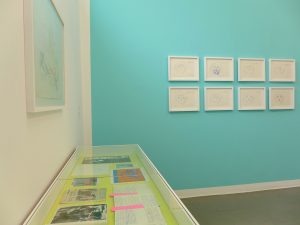
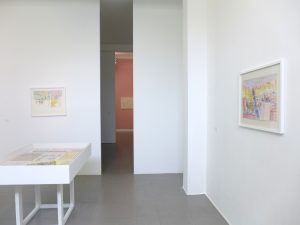
Screening room I: ‘Art Education’, 1976 and ‘Palmistry’, 1973

Space II: Material with regard to the films ‘Art Education’, 1976 and ‘Palmistry’, 1973

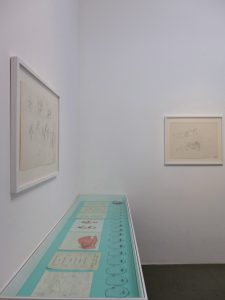
Space III: Material with regard to the film ‘Maria Lassnig Kantate’, 1992
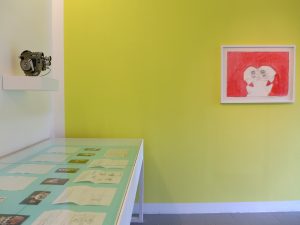
Screening room II: ‘Maria Lassnig Kantate’, 1992
